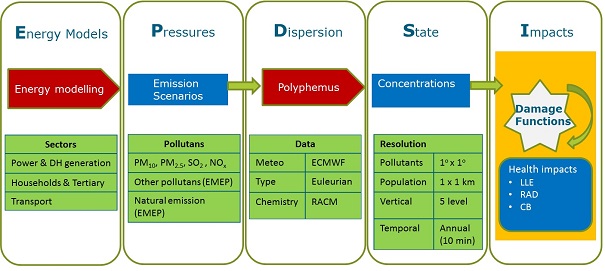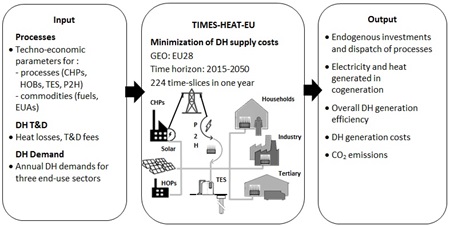Tools developed by the ESMLab
The ESMLab is involved in construction and application of mathematical and computer models of energy systems using mathematical programming, system dynamics and hybrid models combining these methods. The selected tools have been shortly described in the text below and more thoroughlyin the referenced papers. Developed tools are used for the energy system analysis and forecasting to formulate energy policy recommendations at different territorial levels and time perspectives.
- TIMES-PL
- MEDUSA
- πESA
- TIMES-HEAT-EU
TIMES is an economic model generator for energy systems. It belongs to a class of bottom-up models providing a technology-rich basis for analysing energy system development over a long-term period. Its objective function represents the total costs of the supply of energy services, which are minimized by the model. The detailed description of decision variables and equations of TIMES can be found in (Loulou, 2008). TIMES-PL is the name of the model of the Polish power system generated with the use of TIMES. TIMES-PL includes all existing thermal power plants as well as combined heat and power plants. (Gawlik L., Wyrwa A. et al., 2013). These are mainly hard and brown coal-fired plants.

Additionally existing plants, which make use of renewable
energy sources (RES) such as e.g. on-shore wind, photovoltaic, hydro etc., are taken
into consideration. The model can also make decisions to invest in new energy
technologies such as e.g. nuclear, renewables, etc. All technologies included in the
model are characterized by a set of technological and economic parameters.The model was run for the period from 2010 to 2050 with a five-year temporal
resolution and provided results for the central, so called, milestone year. Each
milestone year was further split into 224 time slices in order to better reflect the
temporal characteristics of energy demand and supply (Wyrwa A. et al., 2015).
A new approach for coupling the short- and long-term planning models to design a pathway to carbon neutrality in a coal-based power system was proposed in (Wyrwa A. et al., 2022).
References
Gawlik L., Szurlej A., Wyrwa A. (2015):
The impact of the long-term EU target for renewables on the structure of electricity production in Poland.
Energy (92), p. 172–178. DOI:10.1016/j.energy.2015.05.066.
Gawlik L.Wyrwa A. et al. (2013):
Coal for the Polish power sector in the time perspective up to 2050 - scenario analysis.
Wydawnictwo Instytutu Gospodarki Surowcami Mineralnymi i Energia PAN, isbn: 978-83-904195-6-5.
Available online.
Wyrwa A., Szurlej A., Gawlik L., Suwala W. (2015):
Energy scenarios for Poland a comparison of PRIMES and TIMES PL modeling results.
Journal of Power Technologies (95), p. 100-106.
Available online.
Rogowska D., Wyrwa A. (2021):
Analysis of the Potential for Reducing Life Cycle Greenhouse Gas Emissions from Motor Fuels
Energies (14),3744.
DOI:10.3390/en14133744
Wyrwa A., Suwała W., Pluta M., Raczyński M., Zyśk J., Tokarski S. (2022):
A new approach for coupling the short- and long-term planning models to design a pathway to carbon neutrality in a coal-based power system
Energy (239),122438.
DOI:10.1016/j.energy.2021.122438
Model of Economic Dispatch and Unit commitment for System Analysis (MEDUSA) developed at AGH University of Science and Technology in Poland. The MEDUSA code has been written in the GAMS programming language. As indicated by its name, it is solving a mixed integer problem (MIP) related to the optimisation of unit commitment (UC) and economic dispatch (ED) in electrical power production. The optimization is done with the use of the CPLEX solver. MEDUSA is optimizing the operation of the power system using hourly temporal resolution.

MEDUSA is minimizing the total costs of balancing the forecasted load by making decision whether a dispatchable unit i is in operation at time t and what is its power output taking into account power generation from non-dispatchable
units.
The objective function represents the total costs of balancing the forecasted load including: start-up, shout-down and operation costs, costs of load shifting through demand-side response as well as the costs of load shedding.
References
Pluta, M., Wyrwa, A., Suwała, W., Zyśk, J., Raczyński, M., Tokarski, S.(2020):
A Generalized Unit Commitment and Economic Dispatch Approach for Analysing the Polish Power System under High Renewable Penetration.
Energies, (13), 1952. DOI:10.3390/en13081952.
Pluta M., Wyrwa A., Suwala W., Zysk J. (2019):
Unit commitment and dispatch model of the Polish power system.
Institute for Sustainable Energy - Publishing House, e-ISBN: 978-83-954975-3-7. p. 41.
Wyrwa, A., Suwała, W., Pluta, M., Raczyński, M., Zyśk, J., Tokarski, S.(2021):
A new approach for coupling the short- and long-term planning models to design a pathway to carbon neutrality in a coal-based power system.
Energy. DOI:10.1016/j.energy.2021.122438.
πESA platform designed for optimization of the Poland's power sector considering air pollution and health effects. It belongs to the category of integrated assessment modelling tools and has been develop to support energy and environment policy development in Poland. πESA places much stronger emphasis on computation of a least cost path for power system development while assessing the state (i.e. pollutant concentration) and impact indicators (i.e. due to people's exposure to PM2.5 pollution) in a simulation mode. Its concept is based on the Drivers-Pressures-State-Impact-Response (DPSIR) framework. Based on the chain of causality, πESA links human-caused drivers (use of primary energy sources) to pressures on the environment (emissions), changes of environmental states (air quality, human health) and eventually responses to correct the situation (constraints imposed on energy scenarios).

Drivers, Pressures and Responses are addressed with the use of the energy-economic
model TIMES-PL. States, including the level of ambient air concentration
and deposition of pollutants, are covered by Polyphemus e
which is a full system for air quality modelling. A Module for
Assessment of Environmental and Health Impacts (MAEH) is
developed to estimate the Loss of Life Expectancy indicator (LLE). LLE relates people exposure to PM2.5 concentration with the number of years of life lost per person for a given population cohort which was found suitable for comparative
analysis of energy scenarios.
Registering to PIESA
References
Zyśk J., Wyrwa A., Beata Sliz-Szkliniarz (2021):
Spatially Disaggregated Impact Pathway Analysis of Direct Particulate Matter Emissions.
Springer International Publishing, The Future European Energy System: Renewable Energy, Flexibility Options and Technological Progress, p. 275-289.
10.1007/978-3-030-60914-6_15.
Wyrwa A. (2015):
An optimization platform for Poland's power sector considering air pollution and health effects.
Environmental Modelling & Software (74), p. 227-237.
DOI:10.1016/j.envsoft.2015.04.017.
Zyśk J., Wyrwa A., Suwała W., Pluta M., Olkuski T., Raczyński M. (2015):
The Impact of Decarbonization Scenarios on Air Quality and Human Health in Poland—Analysis of Scenarios up to 2050.
Atmosphere 2020, 11(11), 1222; (74), p. 1-13.
DOI:10.3390/atmos11111222.
TIMES-HEAT-EU has been developed by the ESMLab team within the REFLEX project to assess the transition pathways towards more sustainable district heat supply and to analyze the role of DH systems in enhancing energy system flexibility.TIMES-HEAT-EU is a bottom-up, linear optimization model built with the use of TIMES generator (Loulou, 2008). It belongs to the class of on integrat-ed capacity expansion and dispatch planning models. The goal function, which is maximized by the TIMES-HEAT-EU, repre-sents the total profits of all the actors on the centralized district heat (DC) market. Supply technologies incorporated into the model consist of: (i) Com-bined Heat and Power Plants (CHP), (ii) Heat Only Plants (HOP), (iii) Power-to-Heat Plants (P2H) and (iv) Thermal Energy Storages (TES). The geograph-ical coverage of the model extends over the EU28 Member States. Each coun-try considers its own district heat systems with no trade between countries. The modelling time horizon covers the period from 2015 to 2050 with 5 years’ time steps. Each modelling year is further divided into 224 time-slices derived by aggregating the data every three hours in seven days for four sea-sons (8 x 7 x 4). The annual district heat demand, which is the exogenous pa-rameter into TIMES-HEAT-EU derived from the FORECAST model, is split into three categories depending on the end-use sector to which it is supplied i.e. residential, tertiary or industry. In case of first two sectors the annual de-mand is split into individual time-slices mainly taking into account the varia-tions of the outdoor temperature, whereas for industry it is split rather evenly.

TIMES-HEAT-EU takes into account major EU policies related to the district heating (e.g. requirements determining high efficiency cogeneration). Some more detailed operational constraints (allowable power to heat ratios or ramp rates)
were also defined. The EU emission trading system (ETS) is modelled implicitly with the help of prices for CO2 allowances, and emission fac-tors for individual fuels.
References
Raczyński M., Wyrwa A., Pluta M., Suwała W., Zyśk J. (2021):
Optimal Energy Portfolios in the Heating Sector and Flexibility Potentials of Combined-Heat-Power Plants and District Heating Systems.
Springer International Publishing, The Future European Energy System: Renewable Energy, Flexibility Options and Technological Progress, p. 219-234.
DOI:10.1007/978-3-030-60914-6_12.
J. Michaelis,[...], Wyrwa A. (2017):
Comparison of the techno-economic characteristics of different flexibility options in the European energy system.
IEEE Xplore.
DOI:10.1109/EEM.2017.7981983
Christoph Zöphel,[...], Wyrwa A., Raczyński M. (2015):
Report on cost optimal energy technology portfolios for system flexibility in the sectors heat, electricity and mobility.
Report. European Union’s Horizon 2020 research and innovation programme [GA-No. 691685].
Available online.
.png)